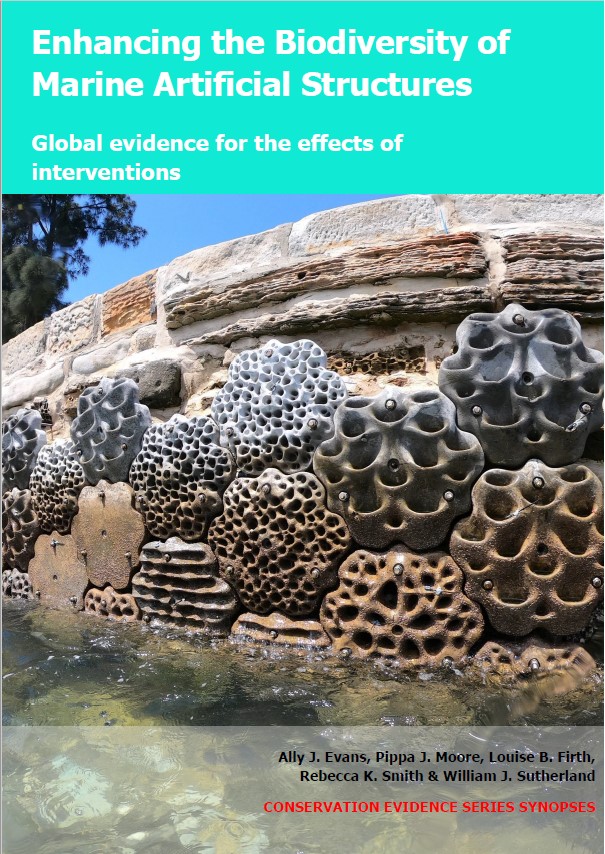Background information and definitions
Definition: ‘Crevice habitats’ are depressions with a length to width ratio >3:1 and depth >50 mm (modified from “Crevices” in Strain et al. 2018).
Crevice habitats provide organisms refuge from predation in subtidal rocky habitats (Nelson & Vance 1979). The size and density of crevices is likely to affect the size, abundance and variety of organisms that can use them. Small crevices can provide refuge for small-bodied organisms but may exclude larger organisms, limit their growth and get rapidly filled-up (Firth et al. 2020). Large crevices can be used by larger-bodied organisms but may not provide sufficient refuge from predators for smaller organisms. By default, crevices contain shaded surfaces, which can be associated with the presence of non-native species (Dafforn 2017).
Crevices are sometimes present on marine artificial structures such as cable mattresses (Lacey & Hayes 2020) but are often absent from other types of structures. Crevices sometimes form on structures through erosion, but are often filled or repaired during maintenance works (Moreira et al. 2007). Crevice habitats can be created on subtidal artificial structures by adding or removing material, either during construction or retrospectively.
There are bodies of literature investigating the effects of creating crevice habitats on artificial reefs (e.g. Briones-Fourzán et al. 2007) and the use of crevice units to sample small/cryptic fauna (e.g. Baronia & Bucher 2008). These studies are not included in this synopsis, which focusses on in situ conservation actions to enhance the biodiversity of structures that are engineered to fulfil a primary function other than providing artificial habitats.
See also: Create natural rock reef topography on subtidal artificial structures; Create pit habitats (1–50 mm) on subtidal artificial structures; Create hole habitats (>50 mm) on subtidal artificial structures; Create groove habitats (1–50 mm) on subtidal artificial structures; Create small adjoining cavities or ‘swimthrough’ habitats (≤100 mm) on subtidal artificial structures; Create large adjoining cavities or ‘swimthrough’ habitats (>100 mm) on subtidal artificial structures; Create groove habitats and small protrusions, ridges or ledges (1–50 mm) on subtidal artificial structures.
Baronio M. de A. & Bucher D.J. (2008) Artificial crevice habitats to assess the biodiversity of vagile macro-cryptofauna of subtidal rocky reefs. Marine and Freshwater Research, 59, 661–670.
Briones-Fourzán P., Lozano-Álvarez E., Negrete-Soto F. & Barradads-Ortiz C. (2007) Enhancement of juvenile Caribbean spiny lobsters: an evaluation of changes in multiple response variables with the addition of large artificial shelters. Population Ecology, 151, 401–416.
Dafforn K.A. (2017) Eco-engineering and management strategies for marine infrastructures to reduce establishment and dispersal of non-indigenous species. Management of Biological Invasions, 8, 153–161.
Firth L.B., Airoldi L., Bulleri F., Challinor S., Chee S.-Y., Evans A.J., Hanley M.E., Knights A.M., O’Shaughnessy K., Thompson R.C. & Hawkins S.J. (2020) Greening of grey infrastructure should not be used as a Trojan horse to facilitate coastal development. Journal of Applied Ecology, 57, 1762–1768.
Lacey N.C. & Hayes P. (2020) Epifauna associated with subsea pipelines in the North Sea. ICES Journal of Marine Science, 77, 1137–1147.
Moreira J., Chapman M.G. & Underwood A.J. (2007) Maintenance of chitons on seawalls using crevices on sandstone blocks as habitat in Sydney Harbour, Australia. Journal of Experimental Marine Biology and Ecology, 347, 134–143.
Nelson B.V. & Vance R.R. (1979) Diel foraging patterns of the sea urchin Centrostephanus coronatus as a predator avoidance strategy. Marine Biology, 51, 251–258.
Strain E.M.A., Olabarria C., Mayer-Pinto M., Cumbo V., Morris R.L., Bugnot A.B., Dafforn K.A., Heery E., Firth L.B., Brooks P.R. & Bishop M.J. (2018) Eco-engineering urban infrastructure for marine and coastal biodiversity: which interventions have the greatest ecological benefit? Journal of Applied Ecology, 55, 426–441.






)_2023.JPG)














